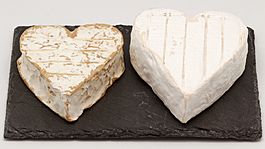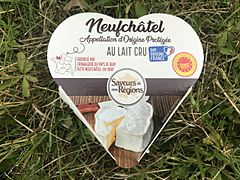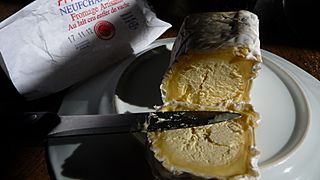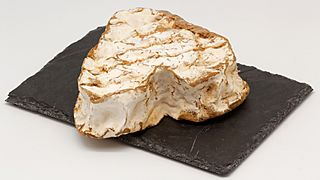Neufchâtel cheese facts for kids
Quick facts for kids French Neufchâtel |
|
|---|---|
 French Neufchâtel in a heart shape.  Texture of French Neufchâtel. |
|
| Country of origin | France |
| Region, town | Normandy, Neufchâtel-en-Bray |
| Source of milk | Cows |
| Pasteurized | sometimes |
| Texture | Soft |
| Aging time | 8–10 weeks |
| Certification | AOC, 1969 |
| Named after | Lua error in Module:Wikidata at line 70: attempt to index field 'wikibase' (a nil value). |
Neufchâtel is a special kind of soft cheese from France. It is made in the Normandy region, near the town of Neufchâtel-en-Bray. This cheese has a white, edible outside layer, called a rind. It tastes a bit saltier and stronger than cheeses like Camembert.
Neufchâtel is one of the oldest cheeses in France. People believe it has been made since the 6th century AD. It often comes in fun shapes, especially hearts. This cheese usually ages for about 8 to 10 weeks.
It's important not to confuse French Neufchâtel with the "Neufchâtel" found in American grocery stores. The American version is different. It's a factory-made cheese that has less fat and more moisture than regular cream cheese.
Contents
The Story of Neufchâtel Cheese
Neufchâtel is the oldest cheese from the Normandy region. People think it was first made around the year 500 AD. We know for sure it was being made between 1050 and 1543.
Cheese for Soldiers
During the Hundred Years' War, there's a cool story about Neufchâtel. Young French girls would give heart-shaped cheeses to English soldiers. This was a way to show their affection and friendship.
Spreading the Word
By the 1600s, Neufchâtel cheese was becoming very popular. It was sent to big French cities like Paris and Rouen. It was even sent across the sea to Great Britain.
Protecting the Quality
In 1880, a farmer named Isidore Lefebvre built a special dairy. Here, he could shape and age cheese curds from other local farmers. His cheese was so good that famous stores, like Harrods, sold it.
To make sure Neufchâtel stayed high quality, a special rule was made. In 1969, the cheese got an "Appellation d'origine contrôlée" (AOC) label. This means that only cheese made in a certain way, in a specific area, can be called Neufchâtel. This rule helps protect the cheese's history and quality.
Fun Shapes of Neufchâtel
Neufchâtel cheese comes in six different shapes. Each shape has a special French name and a different weight.
- Carré (square-shaped), weighing about 100 grams
- Briquette (brick-shaped), also about 100 grams
- Bondon or bonde (a plug or bung shape), weighing about 100 grams
- Cœur (heart-shaped), weighing about 200 grams
- Double bonde (a double plug shape), weighing about 200 grams
- Grand cœur or gros cœur (a large heart shape), weighing about 600 grams
American "Neufchâtel" Cheese
In 1872, a dairyman named William Lawrence in New York created something new. He added cream to a traditional Neufchâtel recipe. This is how the first American cream cheese was made.
The American "Neufchâtel" you find today is different from French Neufchâtel. It is softer than regular cream cheese. This is because it has about 33% less fat and more moisture. Many grocery stores sell it as a lower-fat choice instead of regular cream cheese.
See also
 In Spanish: Neufchâtel (queso) para niños
In Spanish: Neufchâtel (queso) para niños




